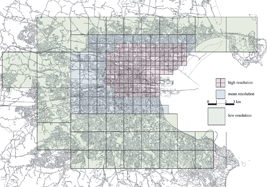The need to collect data representative of overall urban pollution is all-important in order to monitor the population exposure. High spatial resolution monitoring using diffusive samplers allows studying of the urban pollutant distribution, thus enabling deeper investigation of their generation and diffusion mechanisms. Nevertheless, such a monitoring campaign has a certain cost. In this study we point out how to find the best compromise between the number of necessary measurements and the affordable costs for monitoring campaigns. We also describe an innovative method for the proper design of a fixed urban monitoring network by means of preliminary high spatial resolution campaigns using diffusive samplers. Four European capital cities (Dublin, Madrid, Paris and Rome) were monitored six times, each time for seven days. Benzene, toluene, ethylbenzene, xylenes (BTEX) and NO2 concentrations were measured at 146 sites in Dublin, 293 in Madrid, 339 in Paris and 290 in Rome. Multiscale grids have been drawn which ranged in mesh size from 500 m to 2 km. The statistical processing of data produced a twofold result: the creation of isoconcentration maps with geostatistical procedures, and an algorithm aimed at locating the minimum number of sampling sites where the fixed monitoring stations should be placed. Average urban levels estimated on the basis of these selected sites differ by less than 8% from those calculated on the whole populations of the sampled points. The aim of this work is to investigate how far the resolution of a monitoring campaign of urban pollution by diffusive sampling can be reduced, thus making the monitoring less expensive in terms of human and financial resources, while preserving the same quality of the results that could be achieved with a higher resolution. We found that there is no significant loss of information when the resolution of the monitoring grid for BTEX is lowered to a mesh size of 1.85 km, that is a sampling site each 3.4 km2, and that the minimum number of sampling sites to be used is N = 0.29 A, where A is the urban surface to be monitored (in km2). As the spatial distribution of NO2 is less sensitive to the distance from the emission source than that of BTEX, this relationship could be retained as a valid lower limit for the mesh grid size also for NO2 monitoring.


 Please wait while we load your content...
Please wait while we load your content...